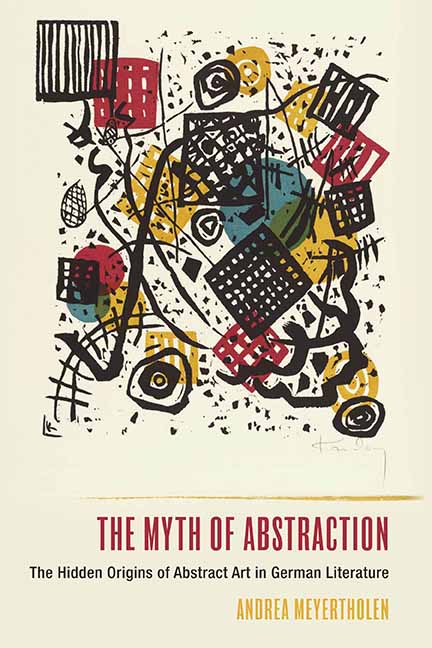Book contents
- Frontmatter
- Dedication
- Contents
- List of Illustrations
- Acknowledgments
- Introduction: The Many Origins of Abstract Art
- 1 Apocalypse Now: Heinrich Von Kleist’s Sublime Deframing of Caspar David Friedrich’s Der Mönch Am Meer (1810)
- 2 The Kleistian Sublime Is Now: Kazimir Malevich, Mark Rothko, Barnett Newman
- 3 The Clouding of Perception: Seeing The (Un)Real Potential for Abstraction in the Poetry and Science of Goethe’s Clouds (1821)
- 4 In the Service of Clouds or Optical Illusion?: Romanticism, Pointillism, and Impressionism
- 5 Driven to Distraction and from Abstraction: The Birth and Death of Abstract Art in Gottfried Keller’s Der Grüne Heinrich (1854/55, 1879/80)
- 6 Inside the Mind and Outside the Margins: The Unruly Lines of Paul Klee, André Masson, and Cy Twombly
- Epilogue: Laocoön and His Sisters: The Future of Literature and Art
- Bibliography
- Index
5 - Driven to Distraction and from Abstraction: The Birth and Death of Abstract Art in Gottfried Keller’s Der Grüne Heinrich (1854/55, 1879/80)
Published online by Cambridge University Press: 07 May 2022
- Frontmatter
- Dedication
- Contents
- List of Illustrations
- Acknowledgments
- Introduction: The Many Origins of Abstract Art
- 1 Apocalypse Now: Heinrich Von Kleist’s Sublime Deframing of Caspar David Friedrich’s Der Mönch Am Meer (1810)
- 2 The Kleistian Sublime Is Now: Kazimir Malevich, Mark Rothko, Barnett Newman
- 3 The Clouding of Perception: Seeing The (Un)Real Potential for Abstraction in the Poetry and Science of Goethe’s Clouds (1821)
- 4 In the Service of Clouds or Optical Illusion?: Romanticism, Pointillism, and Impressionism
- 5 Driven to Distraction and from Abstraction: The Birth and Death of Abstract Art in Gottfried Keller’s Der Grüne Heinrich (1854/55, 1879/80)
- 6 Inside the Mind and Outside the Margins: The Unruly Lines of Paul Klee, André Masson, and Cy Twombly
- Epilogue: Laocoön and His Sisters: The Future of Literature and Art
- Bibliography
- Index
Summary
GOTTFRIED KELLER's semiautobiographical novel Der grüne Heinrich (Green Henry) ultimately comes down to one word: failure. Following the eponymous protagonist on an ill-fated journey to become an artist, its eight-hundred-page plot loosely recounts the author's own attempts from childhood on to make it as a landscape painter in nineteenth- century Switzerland. When Keller's artistic ambitions ended in failure and he took a desk job as an administrative clerk in Zurich, he wrote the Bildungsroman that eventually led to a robust career as an author, even though his fictional alter ego would not experience similar success. Knowing in advance that he wanted Heinrich's life to end in failure, Keller planned Der grüne Heinrich from its unhappy ending and worked backward. Just how tragic and sad a fate Keller's protagonist meets depends on the version: the Heinrich published in 1854/55 version (Heinrich I) wastes away into a solitary death, whereas the Heinrich revised for republication in 1879/80 (Heinrich II) lives on as a melancholy and monosyllabic civil servant. In both versions, Heinrich creates an artwork so bizarre that it pounds the final nail in the coffin for his dreams of painting professionally. Although this artwork closely resembles, if it does not uncannily anticipate, works of abstract art that would be created by twentieth-century painters, within the world of the novel Heinrich's handiwork ultimately amounts to nothing more than a “kolossale Kritzelei” (colossal scrawl) bound for the trash heap and destruction.
Yet the death of this early instance of abstract art so soon after its birth was not inevitable, as intertextual and intratextual references indicate. Comparative analysis with the short story that inspired the Kritzelei episode, “Le Chef-d’oeuvre inconnu” (“The Unknown Masterpiece,” 1831) by Honoré de Balzac (1799–1850) reveals how Heinrich could have behaved differently to save his career as artist and spare the Kritzelei as abstract artwork. Reinforcing this contention are other artist figures that are encountered within the novel and whose accounts implicitly and explicitly parallel Heinrich's trajectory. The artist figures Ferdinand Lys and Oskar Erikson demonstrate potential alternative paths forward and affirm the author's faith in human action.
- Type
- Chapter
- Information
- The Myth of AbstractionThe Hidden Origins of Abstract Art in German Literature, pp. 174 - 206Publisher: Boydell & BrewerPrint publication year: 2021



